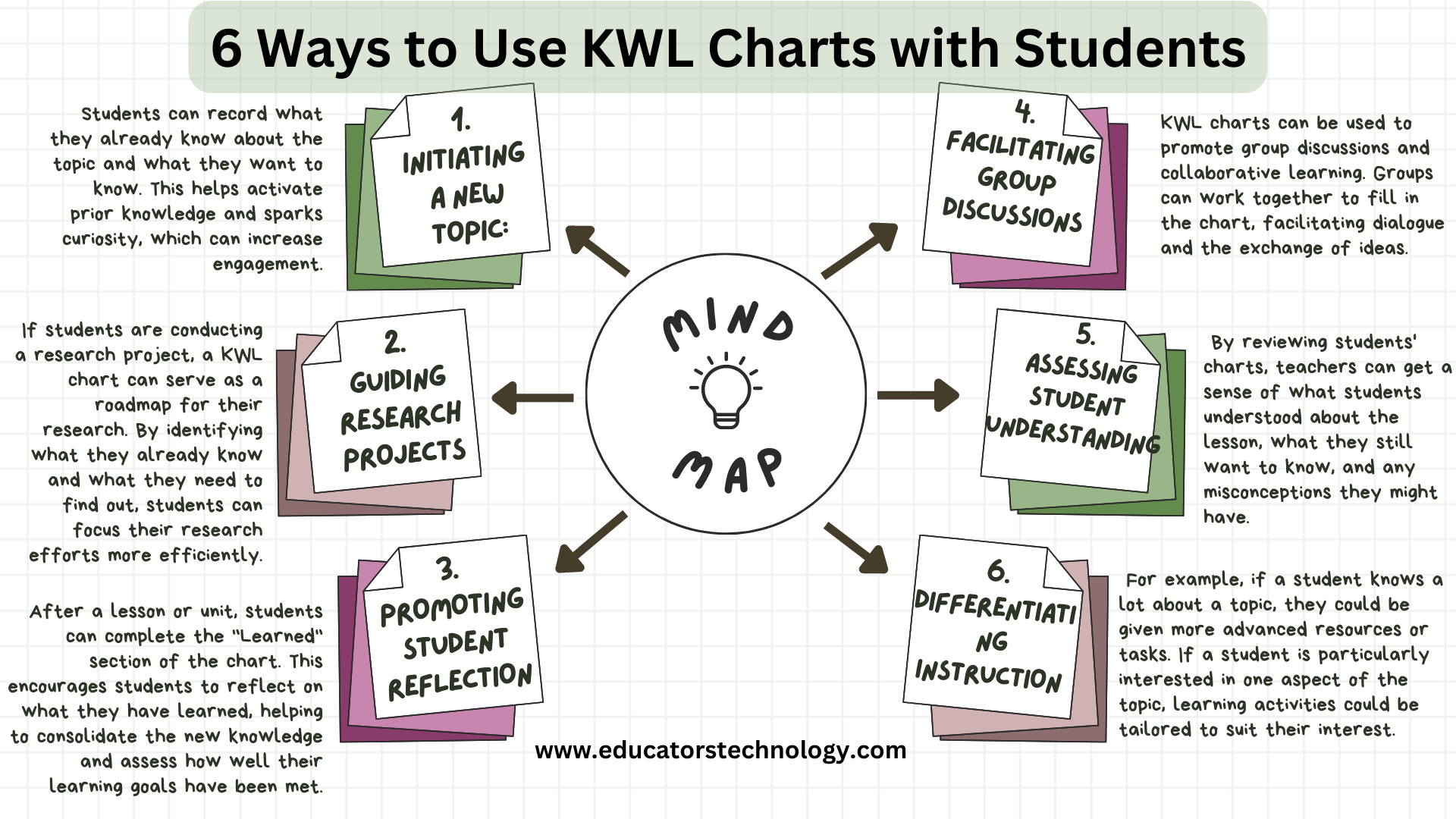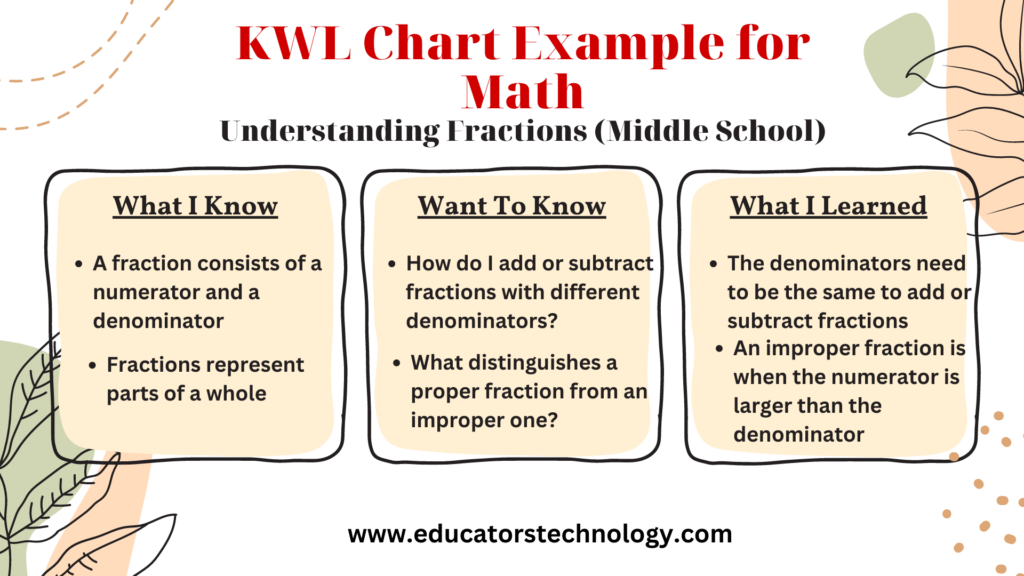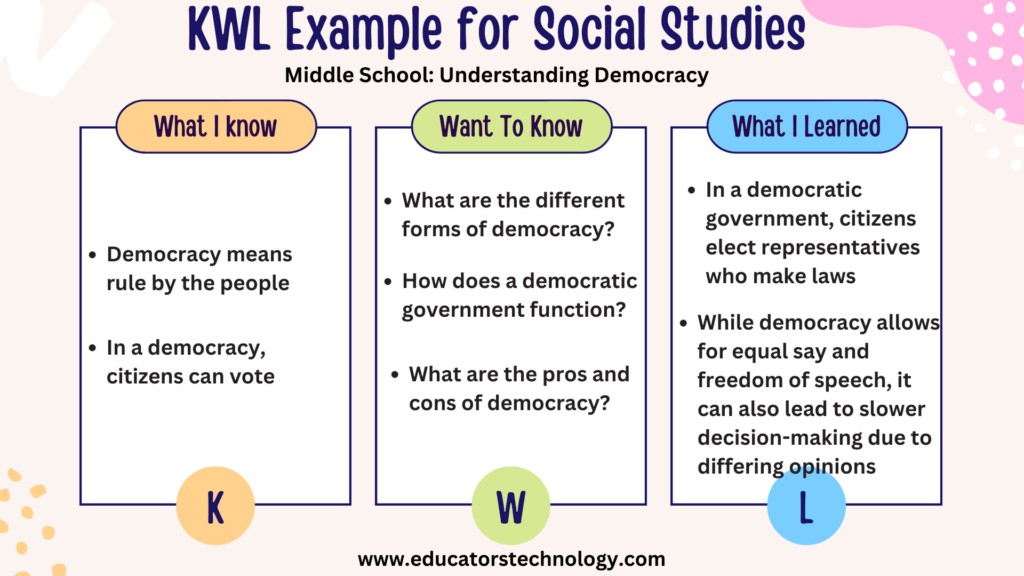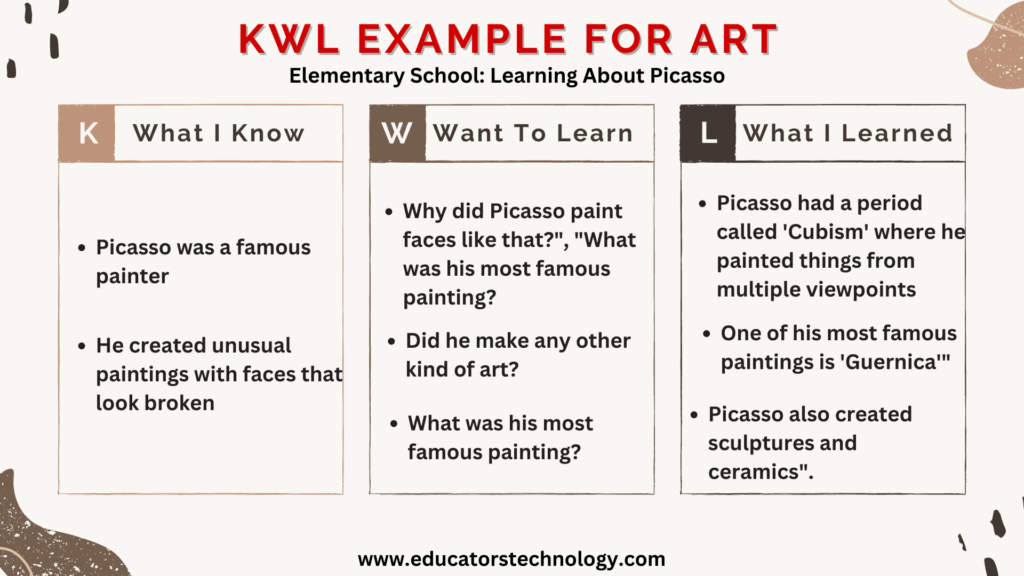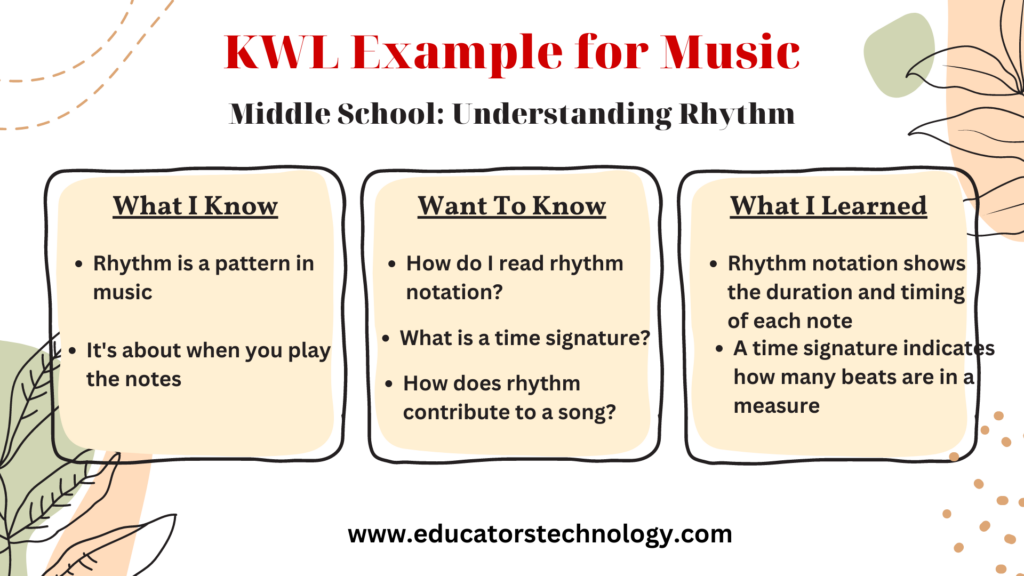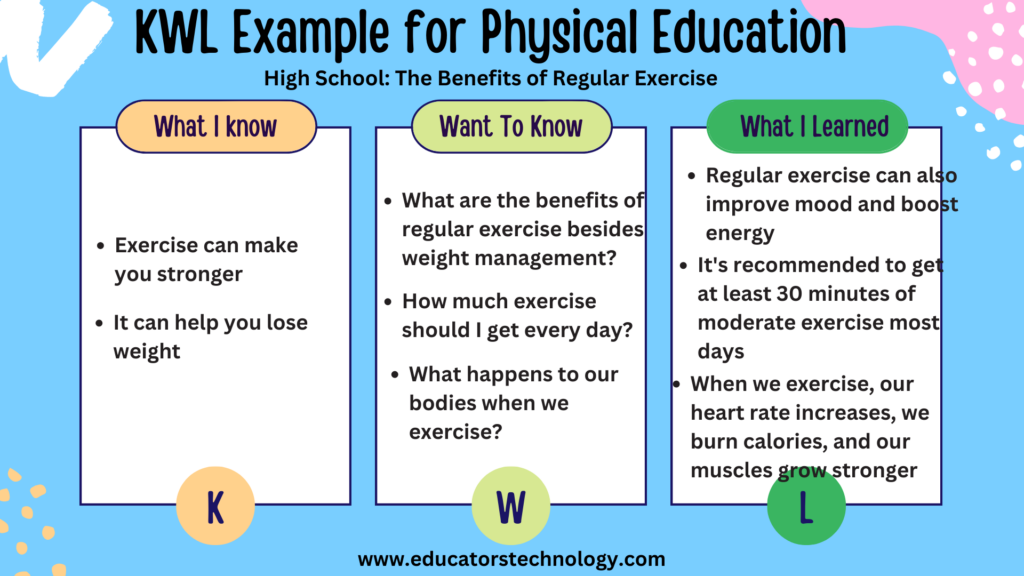If you’ve been following our discussions, you’ll remember that recently we dove deep into the world of KWL charts. We unpacked the details of what a KWL chart is, explored the fascinating pedagogy and science behind this effective tool. The response was heartwarming, and I’m grateful to each one of you who engaged with the content, tried out the templates, and shared your experiences.
However, as any dedicated teacher knows, the real magic of any learning strategy comes to life when it is put into action. So today, I’m excited to bring you the second part of our KWL series – a post teeming with practical, hands-on examples of KWL charts in use across a diverse range of subjects and grade levels.
From taming the beast of English grammar for high school EFL students to exploring rhythm in middle school music class, from understanding democracy in social studies to delving into the art world of Picasso for elementary learners, we’ll be journeying through various classrooms, watching the KWL chart work its wonders.
What is KWL?
Before we explore classroom applications of KWL charts, let’s take a brief moment to refresh our understanding of this insightful learning tool. After all, a thorough grounding in the basics will help us better appreciate the examples we’re about to uncover.
KWL is a simple yet powerful tool used to guide learning and foster comprehension. It’s an acronym that stands for three steps in the learning process:
-
K – What do I Know?: This step encourages students to explore and express what they already know about a topic, tapping into their existing knowledge and experience.
-
W – What do I Want to know?: In this step, students pose questions about what they’re curious about or what they hope to learn. This phase sparks curiosity and sets clear learning goals.
-
L – What did I Learn?: Finally, after the learning experience, students reflect on what they’ve learned, solidifying new knowledge and concepts, and developing metacognitive skills.
This strategy works hand in hand with constructivist theories of learning, catering to different learning styles, promoting active engagement, and fostering a sense of ownership over the learning process.
Now that we’ve refreshed our memories about what a KWL chart is and its function in the learning process, let’s take a look at how this tool comes to life in different classrooms, across various subjects and levels.
Ways to Use KWL Charts with Students
Here are six ways that KWL (Know, Want to Know, Learned) charts can be used in classrooms:
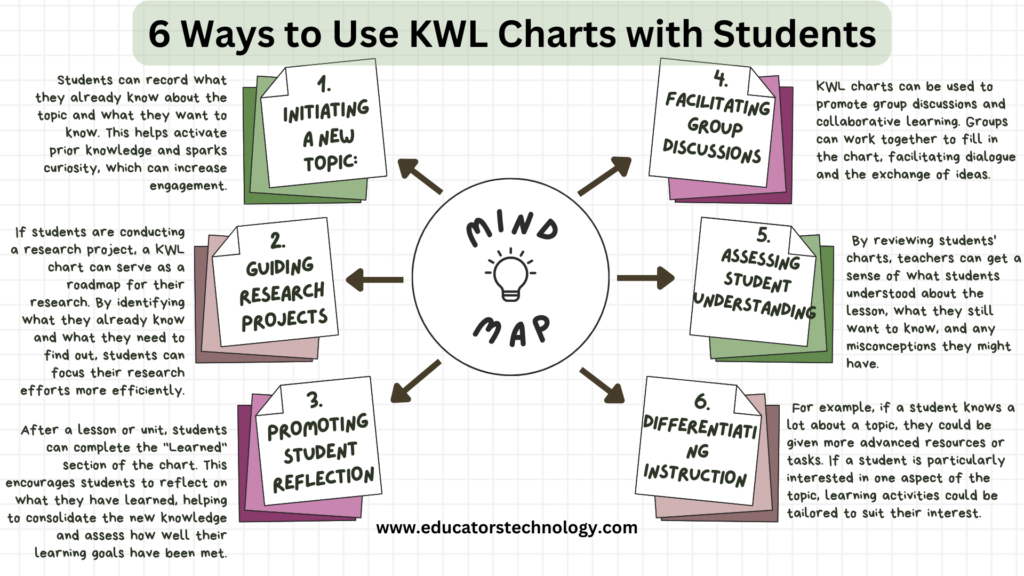
-
Initiating a New Topic: KWL charts can be used at the start of a new lesson or unit. Students can record what they already know about the topic and what they want to know. This helps activate prior knowledge and sparks curiosity, which can increase engagement.
-
Guiding Research Projects: If students are conducting a research project, a KWL chart can serve as a roadmap for their research. By identifying what they already know and what they need to find out, students can focus their research efforts more efficiently.
-
Promoting Student Reflection: After a lesson or unit, students can complete the “Learned” section of the chart. This encourages students to reflect on what they have learned, helping to consolidate the new knowledge and assess how well their learning goals have been met.
-
Facilitating Group Discussions: KWL charts can be used to promote group discussions and collaborative learning. Groups can work together to fill in the chart, facilitating dialogue and the exchange of ideas.
-
Assessing Student Understanding: Teachers can use KWL charts as an informal assessment tool. By reviewing students’ charts, teachers can get a sense of what students understood about the lesson, what they still want to know, and any misconceptions they might have.
-
Differentiating Instruction: KWL charts can be used to differentiate instruction based on student’s prior knowledge and interests. For example, if a student knows a lot about a topic, they could be given more advanced resources or tasks. If a student is particularly interested in one aspect of the topic, learning activities could be tailored to suit their interest.
KWL Examples in the Classroom
Countless teachers are already harnessing the benefits of KWL charts, effectively integrating them into a plethora of classroom contexts. Reflecting on my own teaching journey, I fondly remember employing KWL charts in my high school English as a Foreign Language (EFL) classroom, blending them into diverse language learning tasks.
My personal favorite was utilizing KWL charts to enhance vocabulary learning – it was a joy to witness students embarking on self-directed lexical explorations, driven by their curiosity and active engagement.
To better illustrate the use of KWL in classroom instruction, let’s consider a few examples inspired by actual classrooms.
I have gathered these KWL chart examples into a single PDF available for free download exclusively for our subscribers. If you are not part of the Educators Technology make sure to join us to get access to exclusive EdTech content:
1. KWL Example for Math (Middle School: Understanding Fractions)
Diving into the world of fractions can be a turning point for many middle school students as they transition from basic arithmetic to more complex mathematical concepts. An effective way to begin this journey is through a KWL chart:
-
Know: Students could list basic information they already understand about fractions, such as “A fraction consists of a numerator and a denominator”, or “Fractions represent parts of a whole”.
-
Want to Know: This might prompt questions like “How do I add or subtract fractions with different denominators?” or “What distinguishes a proper fraction from an improper one?”
-
Learned: After exploring the unit, students can fill in this column with their newfound knowledge like “The denominators need to be the same to add or subtract fractions”, or “An improper fraction is when the numerator is larger than the denominator”.
2. KWL Example for Science (Upper Elementary School: The Water Cycle)
The water cycle is a fundamental concept in elementary science education. It provides an excellent opportunity to explore how the Earth’s systems interact. A KWL chart could unfold as follows:
-
Know: Students might share basic knowledge like “Water exists in different forms: liquid, solid, gas”, or “Rain is a form of water”.
-
Want to Know: Students could pose questions such as “How does rain form?” or “What causes evaporation?”
-
Learned: After completing the unit, students can note their learnings like “Evaporation happens when heat energy from the sun causes water to change into a gas”, or “Rain forms through a process called condensation”.
3. KWL Example for Reading ( Elementary School: Exploring a Novel (“
Charlotte’s Web“)
In lower elementary grades, students are beginning to transition from learning to read to reading to learn. Engaging with a novel like “Charlotte’s Web” not only helps develop their reading skills but also encourages empathy and understanding. A KWL chart could look like:
-
Know: Students may share what they already know about the story, such as “It’s a story about a pig named Wilbur and his friend, a spider named Charlotte”.
-
Want to Know: This could prompt questions like “Why does Charlotte want to save Wilbur?”, or “What challenges will they face?”
-
Learned: After reading the book, students can share their discoveries like “Charlotte saved Wilbur by writing messages in her web to convince the farmer not to slaughter him”, or “The story teaches about friendship, sacrifice, and the cycle of life”.
4. EFL (English as a Foreign Language) Example for High School: Learning Present Perfect Tense
Mastering English grammar tenses can be a daunting task for EFL students. The Present Perfect tense, which represents an action that has happened at an unspecified time before now, is a challenging yet crucial concept to grasp. Let’s see how a KWL chart could help:
-
Know: Students could share their existing knowledge about the Present Perfect tense, such as “It uses ‘has’ or ‘have’ with a past participle”, or “We use it to talk about experiences”.
-
Want to Know: This could lead to questions like “When exactly do we use the Present Perfect?”, “What’s the difference between Present Perfect and Simple Past?”, or “How do I form negative sentences or questions in Present Perfect?”
-
Learned: After the unit, students might record their newfound knowledge like “We use Present Perfect to talk about experiences when the time is not important”, “Present Perfect is used when the action has an impact on the present moment, whereas Simple Past is used when the action is completed and has no connection with the present”, or “We form negative sentences by adding ‘not’ after ‘has/have’, and we form questions by changing the order of the subject and ‘has/have'”.
5. Social Studies Example for Middle School: Understanding Democracy
Understanding the fundamentals of democracy is a cornerstone of social studies education. A KWL chart can facilitate students’ understanding of this complex topic:
-
Know: Students could write what they already understand about democracy, such as “Democracy means rule by the people”, or “In a democracy, citizens can vote”.
-
Want to Know: This might prompt questions like “What are the different forms of democracy?”, “How does a democratic government function?” or “What are the pros and cons of democracy?”
-
Learned: After the unit, students could record their learnings like “Democracy can be direct or representative”, “In a democratic government, citizens elect representatives who make laws”, or “While democracy allows for equal say and freedom of speech, it can also lead to slower decision-making due to differing opinions”.
6. Art Example for Elementary School: Learning About Picasso
Studying famous artists like Pablo Picasso can expose students to diverse artistic styles and the history of art. A KWL chart can guide this exploration:
-
Know: Students might share what they already know, such as “Picasso was a famous painter”, “He created unusual paintings with faces that look broken”.
-
Want to Know: This could prompt questions like “Why did Picasso paint faces like that?”, “What was his most famous painting?”, or “Did he make any other kind of art?”
-
Learned: After the unit, students could record their learnings like “Picasso had a period called ‘Cubism’ where he painted things from multiple viewpoints”, “One of his most famous paintings is ‘Guernica'”, or “Picasso also created sculptures and ceramics”.
7. Music Example for Middle School: Understanding Rhythm
Music class often involves more than just learning to play an instrument. Elements of music theory, such as rhythm, are also crucial. A KWL chart can assist with this:
-
Know: Students may list what they already know about rhythm, like “Rhythm is a pattern in music”, or “It’s about when you play the notes”.
-
Want to Know: This could generate questions such as “How do I read rhythm notation?”, “What is a time signature?” or “How does rhythm contribute to a song?”
-
Learned: After the unit, students might write their newfound understanding like “Rhythm notation shows the duration and timing of each note”, “A time signature indicates how many beats are in a measure”, or “Rhythm can make a song feel faster or slower and adds variety to music”.
8. Physical Education Example for High School: The Benefits of Regular Exercise
Physical education goes beyond the games played in class—it also fosters a lifelong understanding of the benefits of exercise. A KWL chart can help students understand this:
-
Know: Students might note what they already know, such as “Exercise can make you stronger”, “It can help you lose weight”.
-
Want to Know: This could lead to questions like “What are the benefits of regular exercise besides weight management?”, “How much exercise should I get every day?” or “What happens to our bodies when we exercise?”
-
Learned: After the unit, students might share their learnings, like “Regular exercise can also improve mood and boost energy”, “It’s recommended to get at least 30 minutes of moderate exercise most days”, or “When we exercise, our heart rate increases, we burn calories, and our muscles grow stronger”.
These examples further emphasize the flexibility of KWL charts across an even wider range of subjects. They serve as an excellent tool to stimulate curiosity, guide learning, and review and reinforce what has been learned.
The post Practical KWL Chart Examples for Teachers appeared first on Educators Technology.
 Latinos Media
Latinos Media 